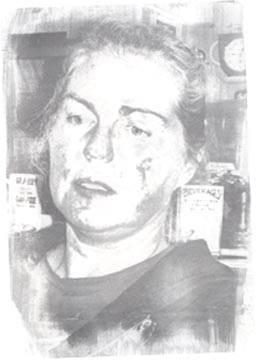There is no particular correspondence between the number of steps and the absolute tonal range. In other words, taking a hypothetical example, a particular pigment mix might produce 11 or 12 steps on a Stouffer 21-step, but the darkest step might only register a reflection log density of .30 or .45, meaning that the emulsion is fairly pale as well as low contrast and each of the steps is a very small increment, tonally, from the next. Or a different mix under the same or different conditions might register a DMax of 1.3, but print only two or three steps, of which the lightest might be .75. And so forth.
Pigment concentration: the page on gum and tonality shows how manipulating pigment concentration affects contrast: the more pigment, the more contrast (fewer steps) and the grittier and coarser the tonal gradations. This relationship applies most closely within the concentrations of a particular pigment; relationships across pigments are more complicated. As a general rule, the heavier mixes are better used for the lower end of the scale in multiple printings, in which case they are printed in such a way (shorter exposures) to ensure DMax but not to print the highlights or midtones, in other words printed as very high-contrast prints.
Development: By manipulating development, you can control contrast to some extent, but only within the limitations of a particular coating mix. For example, you can deliberately increase the apparent contrast by using a mid-to-heavy pigment concentration and shortening development time so that only the highlights and lighter midtones are developed and the midtones and shadows are still blocked at DMax (as shown in an example on the development page). Or, for multiple printing, the traditional way to print the lower end of the scale is to use a heavier pigment mix, shorten the exposure (so as not to print highlights/lighter midtones) and/or increase development to ensure that the highlight tones aren't printed but are left paper-white to be filled in with another printing with a lighter pigment mix (more detailed explanation of why this is important on the page on gum and tonality.)
Dichromate concentration: As shown on the page on dichromate, the more dichromate the less contrast (more steps); the less dichromate, the fewer steps and more contrast, everything else held constant. But keep in mind that greater contrast comes with longer printing times, and is only useful as a control if pigment concentration is held constant, as the difference in contrast achieved by altering the dichromate concentration would be offset by changing the pigment or the pigment concentration. It's that dance of variables thing again: you decide which things to vary and which to hold constant; each has its own implications, advantages and disadvantages. I prefer to keep dichromate constant.
Negative: Using a negative with density set so that highlights aren't printed (in other words, blown highlights) will also increase contrast, even with a light pigment concentration (another example of balancing variables against each other). Again, this wouldn't be my favorite way, but that's just because I like some detail in the highlights. Note that the contrast is increased only within the limitations of the coating mix itself; this coating mix can only print this dark. If you're not going to take advantage of the ability of the light pigment mix to produce beautiful and subtle tonal gradations in the highlights, why use a lighter pigment mix, would be my question. But this would be another way, if used with a heavier pigment mix, to keep the highlights clear when printing the lower end of the scale in a multiple gum print.

Exposure: Exposure is only tangentially related to contrast, and only in the sense that overexposure is sometimes mistakenly interpreted as a contrast issue; sometimes people say a print is "low-contrast" when what they really mean is that it is so profoundly overexposed that no image appears during a "normal" development time, and that all you see is a rectangle of color. I think "low contrast" is a misnomer for such a situation. At any rate, in such a situation if you continue developing, you will eventually get a normal image, unless the image was so profoundly overexposed that the entire gum layer was hardened and there's no soluble gum left in the layer, therefore no printed image, which is unlikely under normal circumstances. At any rate, testing the exposure with a step wedge before making the print should avoid such problems.
Paper: Some papers print with more contrast than others. Fabriano Uno, now discontinued, was the lowest-contrast paper I ever printed on. Some people have claimed that a smoother paper prints with a higher contrast; I've not found this to be true. On the contrary, I find in general that smoother papers can print very smooth subtle tonal gradations that are simply lost on more textured papers; in other words, smoother papers can express a longer tonal scale (more steps, lower contrast) than can textured papers.